 W
WThe Presidency of Cristina Fernández de Kirchner began on 10 December 2007, when she became President of Argentina. She was an Argentine Senator for the Buenos Aires Province at the time of her victory in the 2007 Presidential election. Cristina Fernández de Kirchner became the second female president of Argentina, and the first one directly elected as such. In elections of November 2015, she was succeeded by Mauricio Macri as President.
 W
WThe 7D, which stands for December 7, is a special date in Argentina for the conflict between Fernández de Kirchner government and the media. Feeling that the Clarín newspaper was responsible for the 2008 Argentine government conflict with the agricultural sector and the defeat at the 2009 legislative elections, the government created a media law to force the Grupo Clarín to sell their media assets. Clarín deemed that specific articles of that law that ordered that were unconstitutional, and began a trial over them. Clarín was benefited by an injunction for the duration of the trial, and in 2012 the Court pointed that the injunction should not extend beyond December 7, requesting the judges to make a sentence. The actual events that should take place on December 7 became a huge controversy in Argentina.
 W
W8N is the name given to a massive anti-Kirchnerism protest in several cities in Argentina, including Buenos Aires, Córdoba, Rosario, Mendoza, Olivos, among many others throughout Greater Buenos Aires and other regions; on 8 November 2012. There were also protests in Argentine embassies and consulates in cities such as New York, Miami, Madrid, Sydney, Bogotá, Santiago de Chile, Naples, Zurich and Barcelona, among others. The protest is considered not only a call to Kirchnerism, but also to the opposition, because they did not have a strong leader.
 W
WThe 18A was an Argentine cacerolazo that took place on April 18, 2013. Attended by nearly two million people, it was the largest demonstration against the president Cristina Fernández de Kirchner.
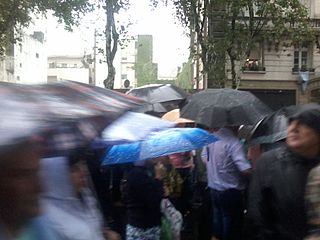 W
WThe 18F was a demonstration that took place in Argentina on February 18, 2015, one month after the death of prosecutor Alberto Nisman. Nisman was investigating the 1994 AMIA bombing, a terrorist attack, and accused the president Cristina Fernández de Kirchner of covering up Iranian suspects. He was found dead at his home the day before he could address the Congress, and his death was still an unsolved case at the time of the demonstration. It was attended in Buenos Aires by 400,000 people, during a torrential storm.
 W
WArgentina held national presidential and legislative elections on Sunday, October 28, 2007, and elections for provincial governors took place on staggered dates throughout the year. For the national elections, each of the 23 provinces and the Autonomous City of Buenos Aires are considered electoral districts. Voter turnout was 76.2%. Buenos Aires Province Senator and First Lady Cristina Fernández de Kirchner of the Front for Victory won the election by 45.28% of votes against Elisa Carrió of Civic Coalition ARI, making her the second female president of Argentina and the first female president to be directly elected.
 W
WLegislative elections were held in Argentina for half the seats in the Chamber of Deputies and a third (24) of the seats in the Senate on 28 June 2009, as well as for the legislature of the City of Buenos Aires and other municipalities.
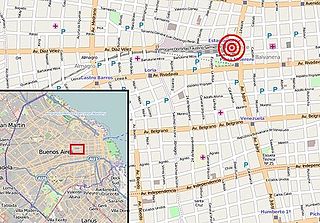 W
WThe Buenos Aires train crash occurred on October 19, 2013 when a passenger train failed to stop at a terminal station in Buenos Aires, Argentina, injuring 105 people. As of October 2013, the causes of the accident were under investigation.
 W
WThe 2015 opening of regular sessions of the National Congress of Argentina took place on March 1, 2015. It was a speech delivered by president Cristina Fernández de Kirchner at the National Congress of Argentina.
 W
WThe Argentina Bicentennial was a series of ceremonies, festivals, and observances celebrated on May 25, 2010, and throughout the year. They commemorated the 200th anniversary of the May Revolution, a sequence of historical events that led to the Viceroy Baltasar Hidalgo de Cisneros being ousted from office and replaced with the Primera Junta, the first national government.
 W
WThe Argentine debt restructuring is a process of debt restructuring by Argentina that began on January 14, 2005, and allowed it to resume payment on 76% of the US$82 billion in sovereign bonds that defaulted in 2001 at the depth of the worst economic crisis in the nation's history. A second debt restructuring in 2010 brought the percentage of bonds under some form of repayment to 93%, though ongoing disputes with holdouts remained. Bondholders who participated in the restructuring settled for repayments of around 30% of face value and deferred payment terms, and began to be paid punctually; the value of their nearly worthless bonds also began to rise. The remaining 7% of bondholders were later repaid in full, shortly after right-wing, US-aligned leader Mauricio Macri came to power in December 2015.
 W
WArgentina held national presidential and legislative elections on Sunday, 23 October 2011. Incumbent president Cristina Fernández de Kirchner of the Front for Victory won via landslide, with 54.11% of votes against Hermes Binner of Broad Progressive Front, she also secured a second term in office after the Front for Victory won just over half of the seats in the National Congress.
 W
WThe Bicentennial of the flag of Argentina was celebrated on February 27, 2012. It commemorated the 200th anniversary of the creation of the flag of Argentina by Manuel Belgrano, during the Argentine War of Independence. Most celebrations took place at Rosario, as the event took place in that city.
 W
WBoudougate is a political scandal in Argentina involving Vice President Amado Boudou and the printing house Ciccone Calcográfica. The AFIP, the revenue service of Argentina, requested Ciccone's bankruptcy in July 2010; but the AFIP reversed itself on September 24, 2010, and rescinded the bankruptcy request. A shell corporation named "The Old Fund", represented by Alejandro Vandenbroele, gave 2.3 million pesos to Ciccone; Vandenbroele became president of the organization as a result. Boudou, who was Minister of Economy at the time, instructed the AFIP to give Ciccone an exceptional moratorium to refinance debts. Boudou denied having any relationship with Vandenbroele, or even knowing about him, but it was confirmed later that Vandenbroele paid the rent and the cable television bill for an apartment belonging to Boudou.
 W
WThe 2012 Buenos Aires rail disaster, also known as the Once Tragedy, occurred on 22 February 2012, when a train crashed at Once Station in the Balvanera neighbourhood of Buenos Aires, Argentina.
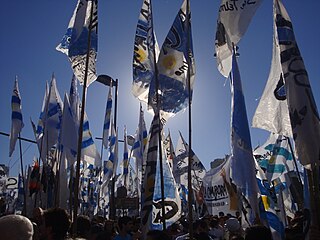 W
WLa Cámpora is an Argentine political youth organization supporting the governments of Néstor Kirchner, Cristina Fernández de Kirchner and Alberto Fernandez. It is named after former Peronist president Héctor José Cámpora. It was established by Máximo Kirchner in 2003 and became politically prominent after the death of former president Néstor Kirchner.
 W
WThe Argentine Governments of Néstor Kirchner and Cristina Fernández de Kirchner had several conflicts with major media groups. Kirchner accused the Clarín Group, La Nación, Perfil, and related media of having promoted their overthrow.
 W
WNéstor Kirchner, former President of Argentina from 2003 to 2007, former Governor of Santa Cruz from 1991 to 2003, former First Gentleman from 2007 to 2010 and the first Secretary General of UNASUR, had died of heart failure on the morning of 27 October 2010 at the Jose Formenti hospital in El Calafate, Santa Cruz Province at the age of 60. Efforts to revive him were unsuccessful. His wife, President Cristina Fernández de Kirchner, was present with him when he died. He was also expected to run for president in 2011.
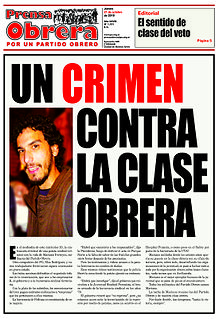 W
WOn 20 October 2010, Argentine student and left-wing activist Mariano Ferreyra was shot dead in Buenos Aires by members of a railway workers union.
 W
WArgentina and Iran signed a memorandum of understanding in 2013 for a joint investigation of the AMIA bombing. The full name was Memorandum of understanding between the Government of Argentina and the Government of Islamic Republic of Iran on the issues related to the terrorist attack against AMIA headquarter in Buenos Aires on July 18, 1994. The memorandum was voided on December 2015, shortly after the inauguration of Argentine president Mauricio Macri.
 W
WPresident Cristina Fernández de Kirchner of Argentina introduced a bill on April 16, 2012 for the partial renationalization of YPF, the nation's largest energy firm. The state would purchase a 51% share, with the national government controlling 51% of this package and ten provincial governments receiving the remaining 49%. The bill was overwhelmingly approved by both houses of Congress, and was signed by the president on May 5.
 W
WA number of cacerolazos, pot-banging protests, took place in several cities of Argentina on September 13 and November 8, 2012. The first, in September 13, was a national protest against the policies of the president Cristina Fernández de Kirchner. The protests generated significant repercussions in local politics. The second, on November 8, was another much more massive protest in several cities in Argentina, including Buenos Aires, Córdoba, Rosario, Mendoza, Olivos, among many others throughout Greater Buenos Aires and other regions. There were also protests in Argentine embassies and consulates in cities such as New York, Miami, Madrid, Sydney, Bogotá, Santiago and Barcelona, among others. Its complaints were almost the same, but the difference in size was very big. The protests are considered not only a call to Kirchnerism, but also to the opposition, because they do not have a strong leader.
 W
WThe Maletinazo, Valijagate, or suitcase scandal was a 2007 scandal involving Venezuela and Argentina, souring friendship between the countries.
 W
WTechnopolis is a science, technology, industry and art mega exhibition in Argentina. It is the largest of its kind in The country. Located in Villa Martelli, in the Vicente Lopez division, Tecnopolis was inaugurated on July 14, 2011, by President Cristina Fernández de Kirchner.
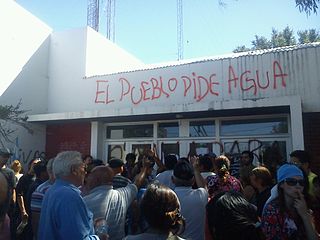 W
WWater supply problems in Caleta Olivia occurred on 2014 and culminated in a series of protests about the lack of water produced by the rupture of the aqueduct Jorge Carstens. The Sarmiento, Comodoro Rivadavia and Rada Tilly areas of Argentina were affected. The water shortage began on the 10th of February with a rupture near ti Cerro Dragón. This issue left the area of San Jorge Gulf without water.
 W
WYacimientos Carboníferos Río Turbio is an Argentinian coal mining company created in 1994 to replace Yacimientos Carboníferos Fiscales, along with the privatization of many other inefficient state-owned enterprises. It was created to extract, ship and sell the coal from the municipality of Rio Turbio.